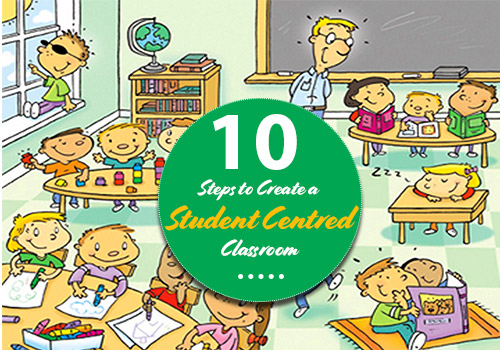When you speak of a traditional classroom, the first image that crosses your mind is the sight of a tutor lecturing to a class.
What about the students? They simply sit without participating in the classroom discussions. This non-participation of students does a great deal of harm, marring the basic premise of learning.
Free Classroom Activity Apps (Check it Now)
In an attempt to encourage students to actively engage themselves with everything that happens in class, a model of instruction called the student-centered classroom is in place.
This is a concept that shifts the focus away from teachers and revolves around students, encouraging them to partake in classroom discussions. All in an attempt to allow students apply their minds, here are 10 intelligent ways to build a student-centered classroom.
- Bestow Students with the Freedom of Choice
A student-centered classroom is one which allows the freedom of choice to students. The teacher can allow them to use their discretion about what projects they wish to work on. For that matter, you can also permit them to choose their bench and the company of their classmates. This sense of freedom will spark creativity in students, alongside strengthening their decision-making skill.
When students enjoy autonomy in everything they do, they will feel less restricted, constantly giving their best to academics or extra-curricular activities. When students apply their knowledge, they will create an environment which promises individual and collaborative learning, while working on a group project.
- Unleash the Power of Student Reflection while Becoming Their Mentors and Coaches
When students are encouraged to reflect upon what they have been learning, they will slow down their pace and introspect their strengths and weaknesses. Teachers can help them analyze their worthiness when they will try to process all that they have learnt in their inquisitive brains. This will help them tread the path of individual and collective growth.
Teachers are the pivots of a student-centered classroom. They are required to implement a learning structure that urges the students to actively participate in classroom activities. Every teacher needs to transform into a mentor delivering deep insights about how learning should progress. Posing questions, having discussions etc will help you comprehend the level of understanding each student has.
This will ultimately lead them to a holistic learning process revolving around their innate intelligence.
- The Inclusion of Academic Workshops and Educational Gadgets
A student-centered classroom works best through workshops along with plenty of professional development opportunities. Teachers should work hard by playing the role of mentors for specific subjects. You should create a concrete lesson plan supported by a host of teaching techniques that will benefit your students. Workshops which focus on different subjects will help students strengthen their fundamentals. In order to facilitate these mechanisms, teachers can sign up for training sessions about the use of teaching gadgets like iPads that will create an environment of personalized learning.
- Demonstrate The Strength of Open-Ended Questioning Techniques
Posing open ended questions allows students to formulate their own answers without sticking to a particular response from a series of answers. Since open-ended questions have no pre-determined limitations or boundaries, students can hone their creative thinking abilities while sharpening their problem-solving skills. You will also create an environment of clear intra-class communication which develops a sense of reassurance that your class welcomes every student’s ideas and thoughts.
- The Formulation of Rules
Autonomy is not about allowing students to do what they like. It is also about following certain non-negotiable rules. Given a scenario when all your students are working towards a group project, you can allow one student to start and lead the discussion. Others will step in through their comments. These comments will again be called for discussion so that you can keep a check on unruly and distractive students. through these boundaries students can make the most of collaborative learning and deliver the project on hand.
- Flip The Assessment Grades With Comments
Treading away from the traditional educational pattern, grades no longer come in as a measure of a student’s success. On the flip side, teachers should change the feedback process which collates all the comments and discussions of students with regard to submission of their assignments. The simple alphabetical grades should be done away with. A conscious effort to uncover the strengths and weaknesses of students through constructive feedback is required.
Academic quizzes and assessments as learning activities can be conducted frequently. This will come handy while collating performance metrics of every student.
- Unveil The Attraction of Student Collaboration
Teachers working towards a student-centered classroom should encourage students to constantly engage themselves in group learning activities. Students should be provided with umpteen opportunities to partake in group discussions. Such activities will not only introduce your students to varying opinions of their classmates, they will also be thrilled to assimilate different views coming from their mates. These activities set the stage for a healthy competition amongst your students.
- The Union of Family and School
For the success of a student-centered classroom, teachers would need the endearing support of the families of their wards. When you are striving towards a student-driven learning pattern, you should work hard in the direction of motivating them alongside making them accountable for all their actions.
These two traits of accountability and motivation should be honed from the home-front as well. Notwithstanding the fact that a school is indeed the second home of every student, it is only when you rope in the parents of your wards that you will derive synergistic benefits of well-informed families teaming with classrooms. For this, it is the need of the hour to educate parents about the principles behind a student-centered classroom so as to reap the benefits of enhanced student participation.
- Chalk Out Individual Assignments
It takes all sorts of students to make up a class. Contrary to the belief that one size fits all, a classroom has students with different IQ levels. They also demonstrate different speeds at which they grasp the classroom learnings. In an attempt to handhold these different students, you can chalk out individual assignments that match varying learning styles. With such assignments in place, students with diverse learning patterns can benefit from an in-depth understanding of the subject.
- Introduce Students To Multiple Learning Avenues
Given the rate at which technology is penetrating into every walk of human life, millennials of today have lots to explore through the internet. You can encourage them to register for online courses which are in tandem with their core interests. Such learning avenues can encourage a motivated student to look at education from a completely different perspective.
Alongside practicing the model of self-learning, students can become a part of experiential learning that is offered by technology like AR (Augmented Reality) and VR (Virtual Reality). All these not only allow students to apply their knowledge but also aid in a significant paradigm shift in the learning methods employed in classrooms. Such technological interventions can become catalysts to a student-centered classroom.
Key Takeaways
After understanding the importance of student-centered classrooms, it goes without saying that this form of learning can lead to a much-needed and exciting educational transition.
All you need to do is to recognize the strengths and weaknesses of your students. After understanding these attributes closely, you can carve a student-centered classroom.



